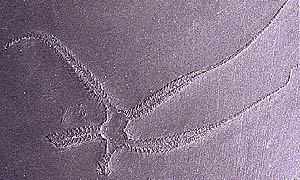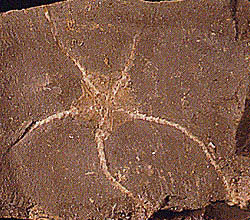Introduction to the Ophiuroidea


Ophiuroids are a large group (over 1600 species) of echinoderms that includes the brittle stars (Ophiurida) and basket stars (Euryalida). The more familiar Ophiurida, or brittle stars, usually have five arms and superficially resemble true starfish (Asteroidea). However, brittle stars have long, flexible arms (hence the other common name for ophiuroids, "snake stars" and a central, armored, disk-shaped body that is clearly demarcated from the arms. Instead of crawling on hundreds of tube feet like starfish, brittle stars move fairly rapidly by wriggling their arms. These agile arms are supported by an internal skeleton of calcium carbonate plates that superficially look like vertebrae, and that are in fact called vertebral ossicles. These are moved by a system of muscles and linked together by ball-and-socket joints. The body and arms are also protected by calcium carbonate plates, and the arms generally bear delicate spines.
Basket stars (Euryalida) have a similar structure to brittle stars, although they are usually larger. However, their arms are very highly forked and branched, and even more flexible than those of brittle stars.
Ophiuroids can be found in most parts of the world, from the Arctic and Antarctic to the tropics. Ophiuroids are common in many shallow-water marine habitats, and include a few species which can adapt to brackish water, which is quite unusual for echinoderms. Ophiuroids are dominant in many parts of the deep sea, where in certain regions the bottom may swarm with brittle starts. Basket stars also tend to live in deeper water. Most ophiuroids are scavengers and detritus feeders, although they also prey on small live animals such as small crustaceans and worms. Some, in particular the basket stars, filter-feed on plankton with their arms.
Ophiuroids and asteroids probably shared a common ancestor. Early members of both appear in the early Ordovician, roughly 500 million years ago. Ophiuroids are not common fossils; as you might expect from the name "brittle star", ophiuroids rapidly fall to pieces after death, and are rarely preserved whole. At the top of this page is a specimen of Furcaster from the Hunsrück Slate of western Germany, a locality famous for its outstanding preservation of delicate fossils. Furcaster belongs to an extinct group of brittle stars, the Oegophuroidea. Instead of a single chain of "vertebrae" supporting the arms, oegophiuroids had two rows of supports alternating down each arm. This gave the arms a "zippered" appearance. Oegophiuroids went extinct in the Mississippian (late Carboniferous) period. The ophiuroid shown below has not been described, but is in the Ophiurida (true brittle stars) and is possibly referable to the genus Ophiura, which is still extant. This is a much later ophiuroid, from the late Cretaceous-age Moreno Formation, in the Panoche Hills of Fresno County, California.

UCMP alumnus Ben Waggoner is collaborating on describing some fossil ophiuroids from the Ozark Mountains of northern Arkansas. Check 'em out.

Hyman, L. H. 1955. The Invertebrates. Volume IV; Echinodermata. McGraw-Hill, New York.

